2020 下半年福建教师资格高中英语学科知识与教学能力真
题及答案
注意事项:
1.考试时间为 120 分钟,满分为 150 分。
2.请按规定在答题卡上填涂、作答。在试卷上作答无效,不予评分。
一、单项选择题(本大题共 30 小题,每小题 2 分,共 60 分)
1. /s/ and /z/ can be distinguished by the
.
A. place of articulation
B. state of tongue
C. state of vocal cords
D. manner of articulation
【答案】C
2. The word “realization" consists of
syllables and
morpheme.
A. five; five
C. four; three
【答案】C
B. five; four
D. four; four
3. Which of the following is least associated with newspaper publishing?
A. proofreading
C. censorship
【答案】D
B. editorial
D. citizenship
4. Which of the following best describes the relation between "piece” and
"peace”?
A. synonymy
C. antonymy
【答案】B
B. homonymy
D. hyponymy
5. She was not impressed by the story Paul shared with her, for she had already
heard of it.
A. in the least
C. least of all
【答案】A
B. at the most
D. for the most
6. Without facts, we can't form worthwhile opinions, for we need to have factual
�
knowledge
our thinking.
A. which to be based upon
B. upon which to base
C. which to base upon
D. upon which to be based
【答案】B
7. It's true that water will continue to be
it is today—in importance to
oxygen.
A. how
C.as
【答案】D
B. which
D. what
8. He is helpless under such circumstances,
.
A. however brilliant a mind he may have
B. however a brilliant mind he may have
C. however brilliant a mind may he have
D. However a brilliant mind may he have
【答案】A
9. Which of following refers to "the part of input that has been internalized
by learners”?
A. feedback
C. Intake
【答案】C.
B output
D. washback
10. Which of the following describes the language of an individual speaker with
its unique characteristics?
A. Idiolect
B. Taboo
C. Regional dialect
D. Social dialect
【答案】A
11. What role does he/she play when a teacher explains the purpose of a task,
the steps to do it and its time limit?
A. An organizer.
C. An evaluator
B. An observer
D. A prompter
�
【答案】A
12. What does he/she intend to do when a teacher writes the following sentences
“She gets up early. She wears a uniform. She works very hard.” on the blackboard
at the presentation stage?
A. Practice sentence patterns using model sentences.
B. Check if students can pronounce the sentences correctly.
C. Monitor whether students can accurately express their ideas.
D. Draw students' attention to the form of a new language item.
【答案】D
13. What skill does he/she use when a student uses language knowledge and
contextual clues to figure out the meaning of a new word?
A. Contrasting.
B. Summarizing
C. Deducing
【答案】C
D. Predicting
14. Supplementing, deleting, simplifying and reordering are often used
in
.
A. adapting teaching materials
B. delivering teaching materials
C. evaluating teaching materials
D. presenting teaching materials
【答案】A
15. Which of the following is least recommended at the lead-in stage in a reading
class?
A. Activating students' schema of the topic.
B. Giving advice on how to use reading strategies.
C. Sharing background information about the text.
D. Correcting language mistakes students have made.
【答案】D
16. Which of the following best describes the phenomenon that learners apply
the skills acquired in one field to another?
A. Transfer
B. Deduction
C. Contextualization
D. Induction
�
【答案】A
17. If the focus is placed on
, students are supposed to go through the stages
of drafting, receiving feedback, and revising before submitting the final version
of their writing.
A. Product
D. format
【答案】B
B. process
C. genre
18. What would he/she do in a reading class if a teacher wants to develop
students' inferential comprehension?
A. Ask them to retell the story.
B. Ask them to underline difficult sentences.
C. Ask them to read the text sentence by sentence.
D. Ask them to read the text for implied meaning.
【答案】D
19. Which of the following activities can be used if the focus is on developing
students' oral fluency in English?
A. Blank-filling.
B. Story-telling.
C. Transformation.
D. Translation.
【答案】B
20. What is the focus when a teacher says to the class" Rewrite each of the
following sentences using the passive voice.”?
A. Skill
C. Structure
【答案】C
B. Meaning
D. Function
请阅读 Passage1, 完成第 21~25 小题。
Passage 1
I have personally come to understand that “empowerment” is not a lesson that
can be thought by way of textbooks or lectures, projects or field trips, and not
even by way of principles and inspirational teaching. It must be taught by personal
examples.
�
When we ask our students who come from disadvantaged backgrounds, or those, who
face a personal lifestyle this in direct conflict to the principles that we teach,
we have to be willing to show them how to overcomer, how to make the transition from
one state of being into the next, how to be empowered. We must make the lesson of
empowerment come to life, in a real, up-dose and personal way. And the only way this
can be done is when we al low ourselves to become living examples of what we teach.
Preparatory school for Global Leadership (PSCL) is a school that I started
because I believed that I had method, a way of teaching and learning that would
empower the urban disadvantaged child. But as l sit back and think about it now,
PSGL was a school that I started so that I would showcase empowerment to a group
of students (and stuff) who needed a real life, example of how to grow beyond one'
s current circumstance.
When l reflect on my journey of starting the school, I realize that every step
along the way was personally teaching about empowerment. It is one thing to teach
it, but it is another to live it. Unless we experience empowerment on a personal
level, we can not help students learn it, circumvent obstacles as they arise and
develop and employ the new skills needed to function to be empowered.
How can we get in the face of a student and push him to a place that is foreign
and scary, asking him to become greater than his environment? We can't, why? Because
we do not know what it lacks like, we do not know what it feels like. Our role as
a teacher becomes technical, causing us to miss out on the spirit of truly good
teaching, where one teaches with relevancy, authenticity and experience.
When I look at the faces of these students, I know that my process of starting
the school was for them. When I became what I taught, when I empowered myself in
spaces where there was no one there to empower me, when I chose to succeed without
excuses, I became a living lesson.
These students saw me and our staff as extensions of the lessons we were trying
to teach. Our lives, not by our perfection, but by our effort, showed students how
to apply what we taught.
21. Which of the following can be regarded as a necessary condition for teachers
�
to empower their students?
A. Having been successful in empowering students.
B. Possessing the expertise in the subject they teach.
C. Having received adequate training on empowerment.
D. Being able to integrate personal experiences into their teaching.
22. Which of the following can be inferred from the passage?
A. Only children from disadvantaged background need to be empowered.
B. The author is able to empower herself when faced with difficulties.
C. Teachers with personal experience of empowerment cannot teach.
D. The author does not practice what she advocates in her own life.
23. Which of the following is true about the Preparatory School for Global
Leadership?
A. It is the most renowned of its kind in the world.
B. Its graduates are well received by their employers.
C. Its staff are unwilling to empower themselves as living examples.
D It aims at empowering trainees to grow beyond their circumstances.
24. Which of the following is closest in meaning to the underlined word
"circumvent” in Paragraph 4?
A. Overcome.
C. Move around.
B. Encounter.
D. Take away.
25. Why does the author highly value a teacher's experience of empowerment in
teaching?
A. To enable students to learn and use new skills.
B. To turn teaching technical with dogmatic lectures.
C. To make teaching relevant, authentic, and convincing.
D. To extend and perfect his professional career as a teacher.
21.【答案】D
22.【答案】B
23.【答案】D
24.【答案】A
�
25.【答案】C
请阅读 Passage2,完成第 26~30 小题。
Passage 2
Cats have the widest hearing range of nearly any mammal” not only can they
perceive sound in what we define as the "ultrasonic" range, they can also appreciate
all the bass Dr Dre can throw at them. They can swivel their whiskers forwards while
hunting to provide a kind of short-range radar. And they can see exceptionally well
in the dark thanks to a reflective surface behind the retina that bounces light back,
giving it a second chance to hit a photoreceptor. They see more distinct images per
second than we do.
Dog partisans will appeal to the dog' s allegedly superior intelligence —
though if that were the primary criterion for choosing a pet, one would expect to
see a lot more crows and squid on leads around town. In fact, cats are rather cleverer
than commonly assumed, as the biologist and animal-behaviour expert John Bradshaw
shows in his new book. They can even be trained to an extent which was news to me
Bradshaw' s book mixes pellets of cat lore with accounts of feline evolution, anatomy,
genetics and development from newborn kitten to adulthood, plus descriptions of
cat-psychology experiments in the laboratory, many of which he has conducted himself.
Some of the most interesting parts indicate holes in our current scientific knowledge.
"Many mother cats try to move their litters at least once before they wean them,”
he observes," but science has yet to find out why". No one knows why cats go crazy
for catnip, nor why they are able “to classify shapes according to whether they
are closed or open.” Kittens, meanwhile, "may also use special movements of their
tails to signal playfulness, but so far no scientist has been able to decode these".
As far as potential research projects go, decoding the tail-language of playing
kittens must be about the interesting unsolved problem in science.
The cat is an apparently phlegmatic beast, but Bradshaw points out that cats
experience strong emotions, and sometimes might be suffering in silence. They aren't
particularly sociable, and cats who are housed with others who weren't litter-mates
- perhaps by well-meaning owners who think they need the company — can become
�
chronically stressed.
Luckily, then, cats probably aren't aware that today they are once again
hate-figures, the furry target of spittle-spraying ecologists who, armed with dodgy
statistics, accuse cats of wildly "murdering" all the country's songbirds. It's a
bit more complicated than that, Bradshaw shows. Rats also kill songbirds, and cats
keep their numbers down; while the RSPB says the disappearance of habitat is a far
more important factor in the decline of songbird populations than predator numbers.
But we could at least, Bradshaw suggests, reverse the counterproductive selection
pressure we currently exert on the domestic cat when we neuter house cats before
they reproduce. This means, he explains, that the "friendliest, most docile” cats
are prevented from leaving any descendants, while wild cats — which are more
suspicious of humans and better at hunting — will leave more offspring.
Unintentionally, we are causing cats to evolve into animals society won't like as
much.
Cat-haters probably won't appreciate this book, but anyone else might. It is
written in a friendly and engaging way, has helpful tips for cat owners, and is packed
with excellent cat facts. Why, you might have wondered, do cats get stuck up trees?
Because all their claws face forwards, so none can be used as brakes on the descent.
We all know how good cats are at twisting mid-air to land on their feet, but they
have an even more impressive trick: some cats ado a "parachute" position during a
long fall, with all four legs stuck out to the side, before coming back to the landing
position at the last moment. This cat-parachute pose, Bradshaw calculates," limits
the falling speed to a maximum of fifty-three miles an hour” so enabling some cats
to fall from high-rise buildings and walk away unhurt. l' d like to see a dog try
that.
26. What can be inferred about cats from Bradshaw's research?
A. Cats' whiskers can aid them to confuse preys.
B. Cats can detect sounds far away from them.
C. Cats can process images better than we do.
D. Cats' intelligence has been underestimated.
�
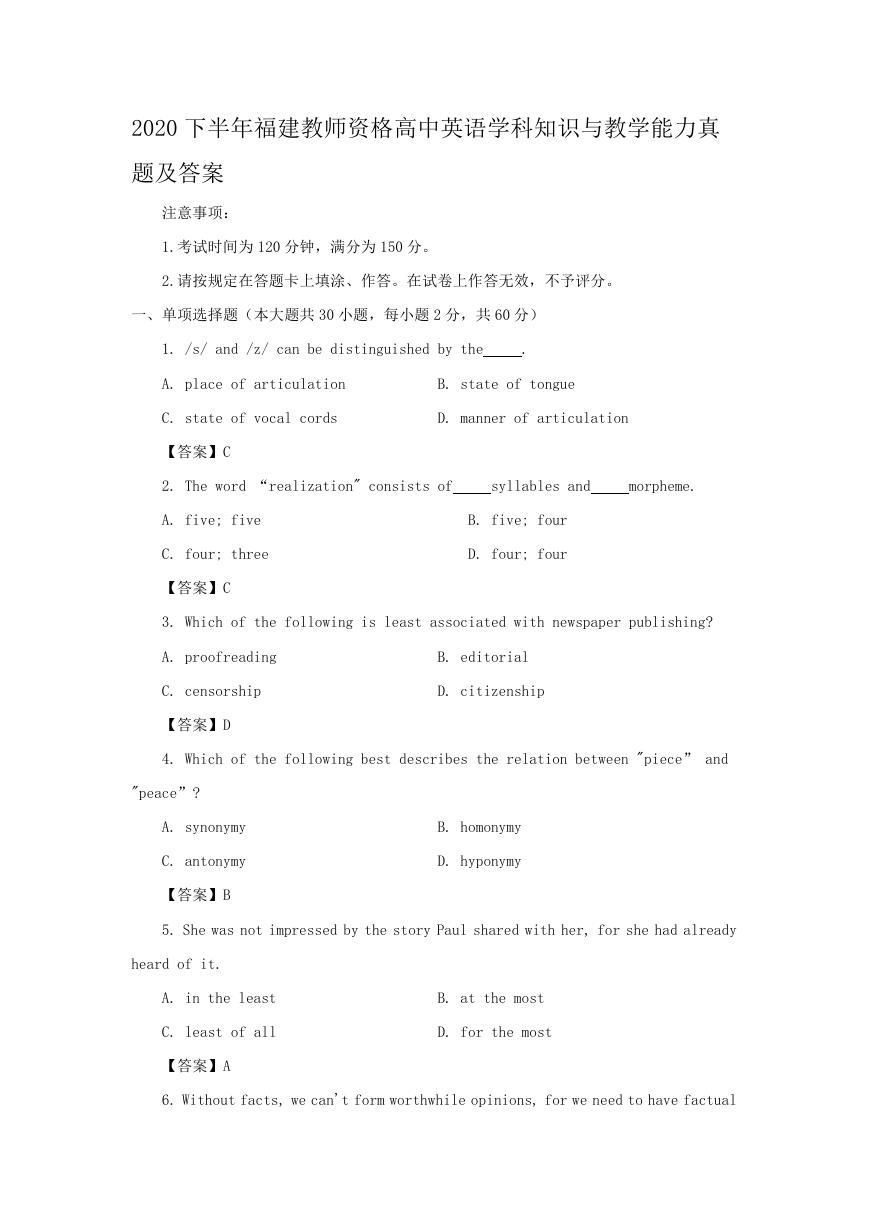
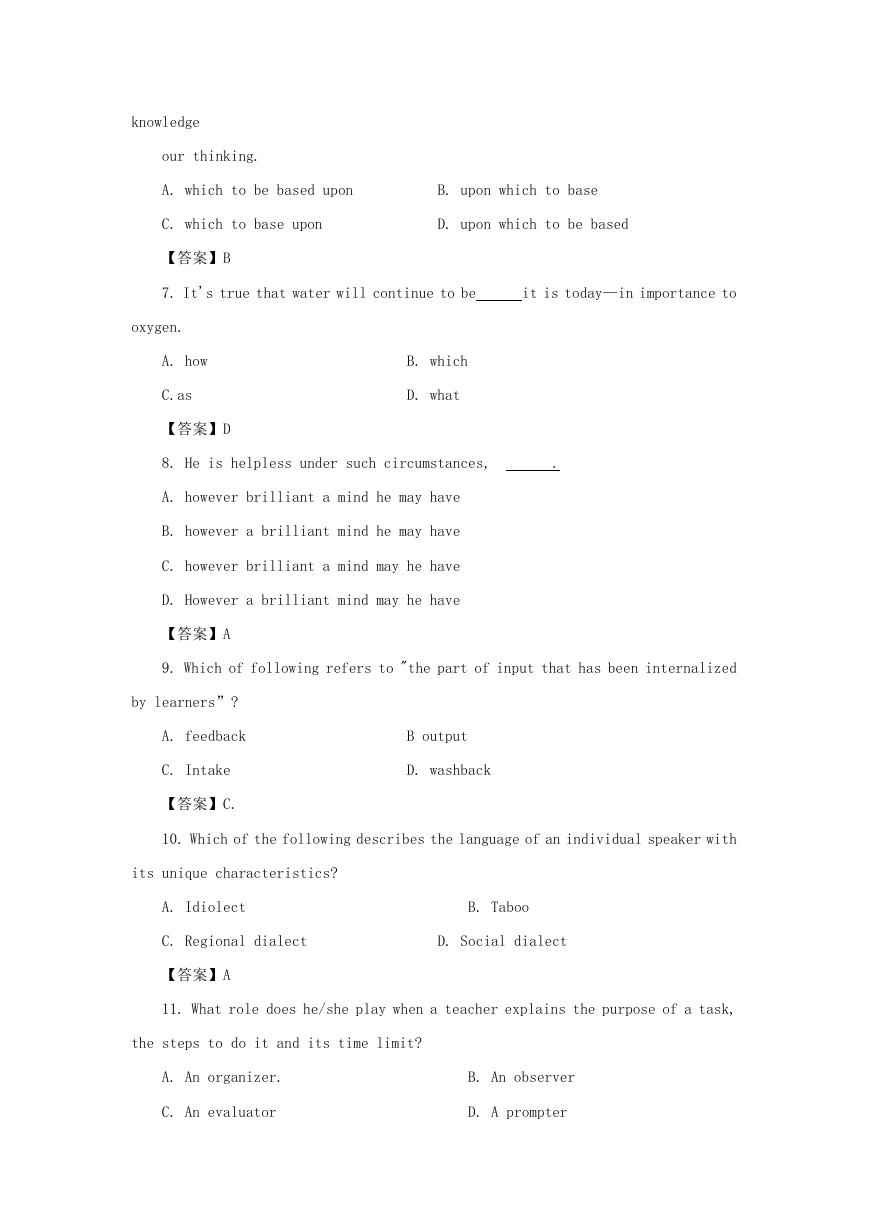
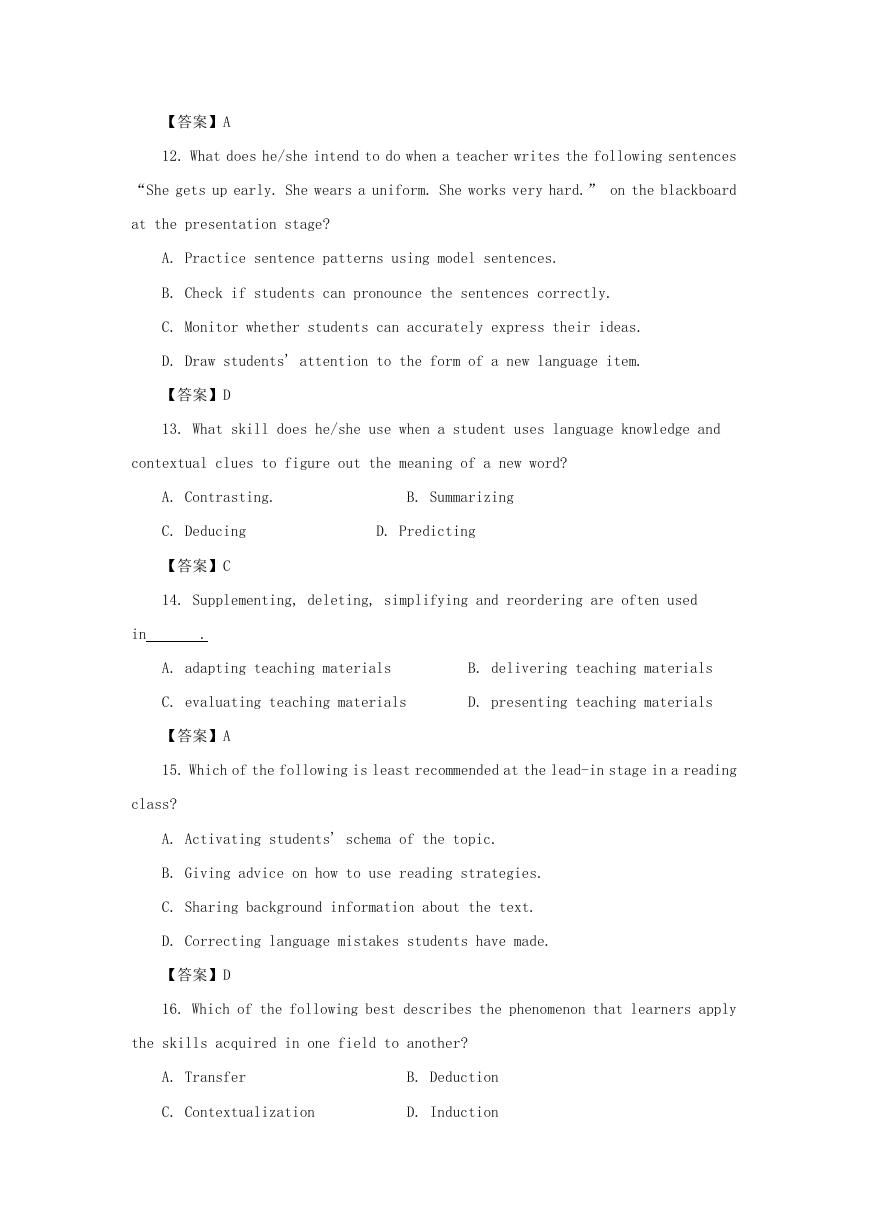

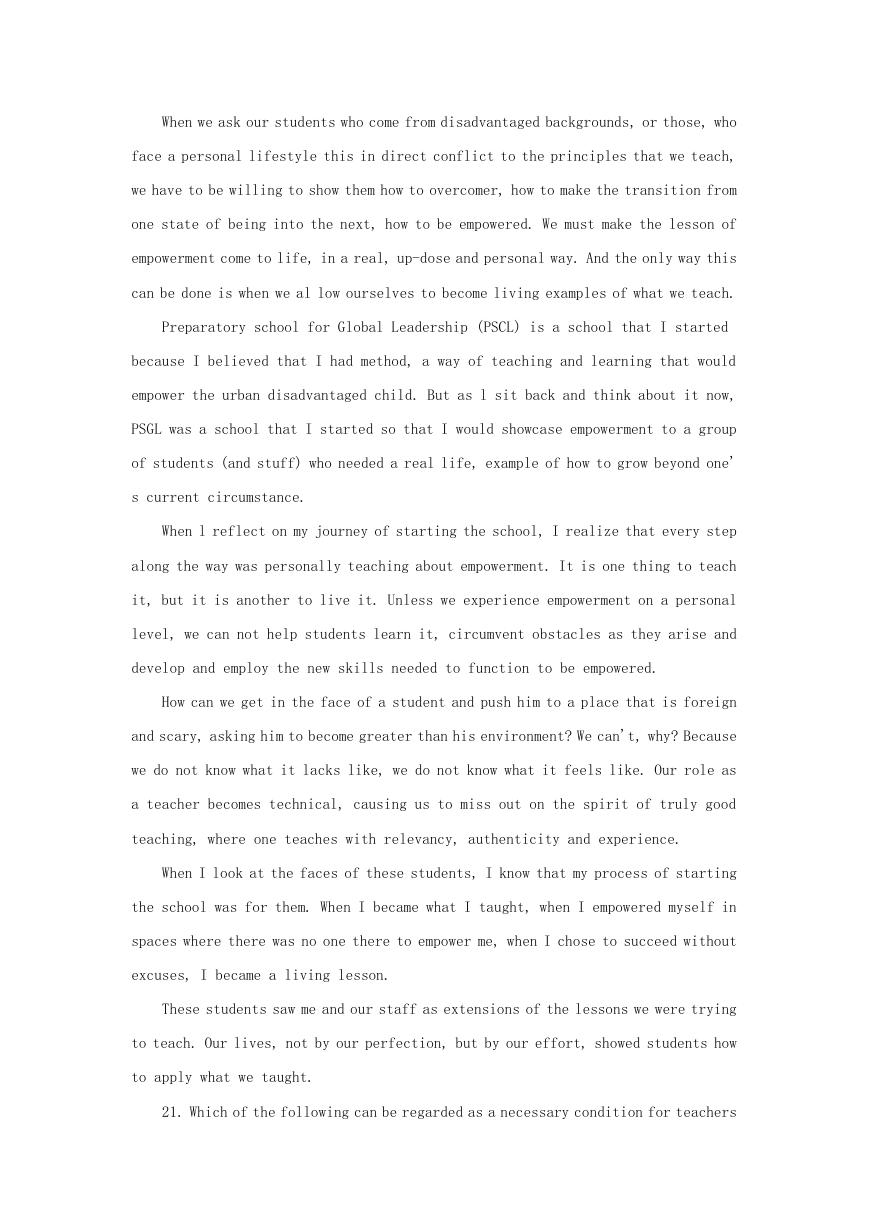
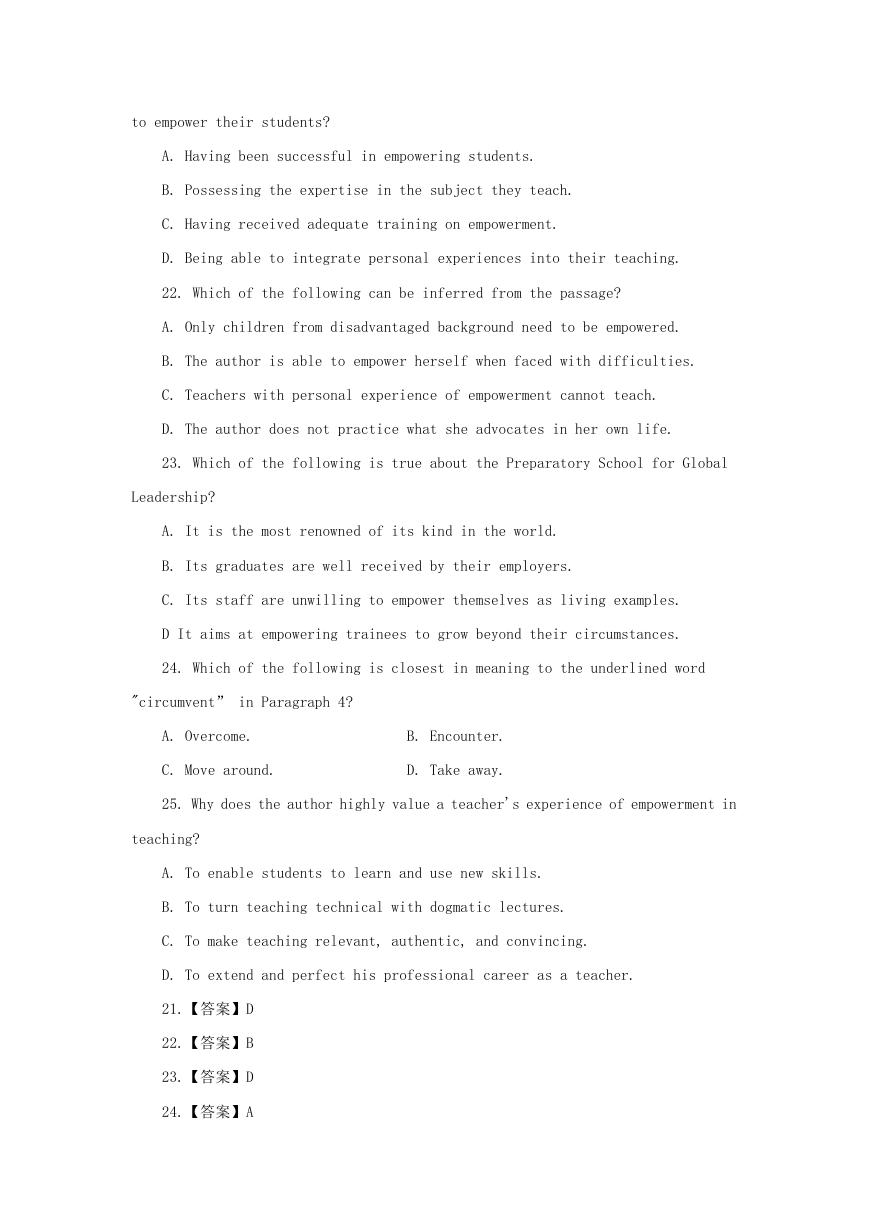
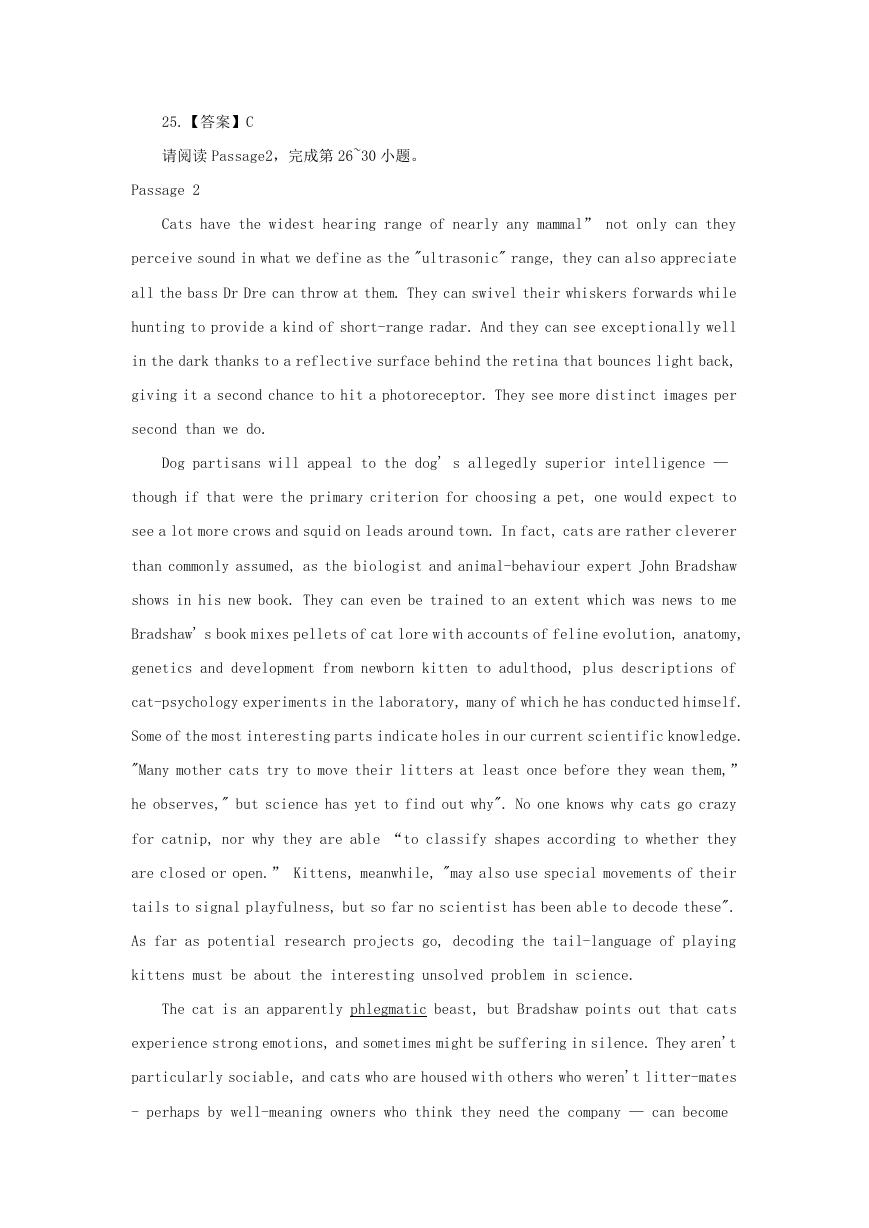
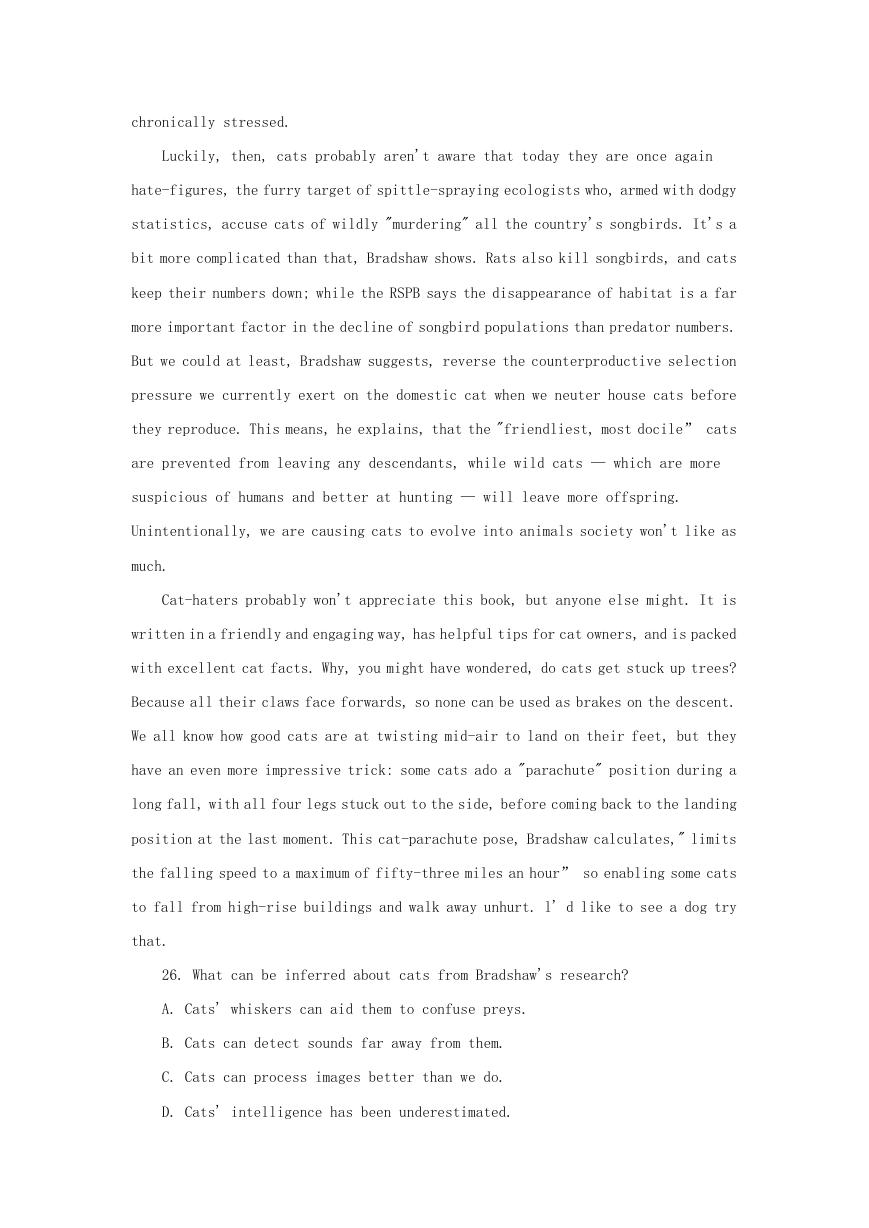








 2023年江西萍乡中考道德与法治真题及答案.doc
2023年江西萍乡中考道德与法治真题及答案.doc 2012年重庆南川中考生物真题及答案.doc
2012年重庆南川中考生物真题及答案.doc 2013年江西师范大学地理学综合及文艺理论基础考研真题.doc
2013年江西师范大学地理学综合及文艺理论基础考研真题.doc 2020年四川甘孜小升初语文真题及答案I卷.doc
2020年四川甘孜小升初语文真题及答案I卷.doc 2020年注册岩土工程师专业基础考试真题及答案.doc
2020年注册岩土工程师专业基础考试真题及答案.doc 2023-2024学年福建省厦门市九年级上学期数学月考试题及答案.doc
2023-2024学年福建省厦门市九年级上学期数学月考试题及答案.doc 2021-2022学年辽宁省沈阳市大东区九年级上学期语文期末试题及答案.doc
2021-2022学年辽宁省沈阳市大东区九年级上学期语文期末试题及答案.doc 2022-2023学年北京东城区初三第一学期物理期末试卷及答案.doc
2022-2023学年北京东城区初三第一学期物理期末试卷及答案.doc 2018上半年江西教师资格初中地理学科知识与教学能力真题及答案.doc
2018上半年江西教师资格初中地理学科知识与教学能力真题及答案.doc 2012年河北国家公务员申论考试真题及答案-省级.doc
2012年河北国家公务员申论考试真题及答案-省级.doc 2020-2021学年江苏省扬州市江都区邵樊片九年级上学期数学第一次质量检测试题及答案.doc
2020-2021学年江苏省扬州市江都区邵樊片九年级上学期数学第一次质量检测试题及答案.doc 2022下半年黑龙江教师资格证中学综合素质真题及答案.doc
2022下半年黑龙江教师资格证中学综合素质真题及答案.doc